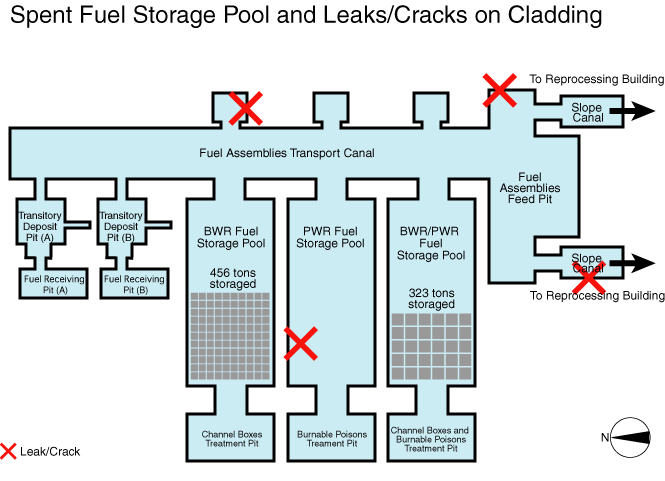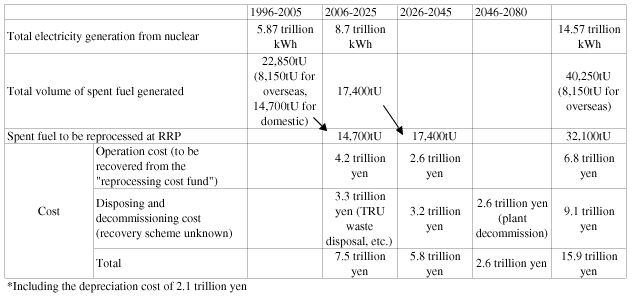Rokkasho Reprocessing Plant: Leakage from Storage Pool, Defective Construction Work, and Escalating Costs Nuke Info Tokyo No. 95
At the Rokkasho Reprocessing Plant (RRP) in Aomori Prefecture, a series of accident has been discovered in the spent fuel storage pool – water leakage from the storage tank and the defective construction work on the pool since July 2001. The accidents show that the safety operation of the reprocessing plant has never been established in terms of the actual technical condition of the plant (For background information on the water leakage accident, see Nuke Info Tokyo No. 88, p. 6-7). A preliminary cost calculation was made to estimate a total cost of the reprocessing project. The result shows that the final cost required for RRP is expected to reach 16 trillion yen.

Figure 1. Cross section of the spent fuel storage pool where several leaks and cracks were found. Crosses in the figure indicate points of leakage.
Endless leakage from spent fuel storage pool
After 16 months of slow and sluggish investigation by Japan Nuclear Fuel Limited (JNFL), the manufacturer of the storage tank, Oye Kogyo Co., was found to have carried out welding works to attach steal plates inside a storage tank and to be responsible for the accident. As figure 1 illustrates, there are three pools inside the facility where spent fuel is stored and cooled before it moves to the shearing and dissolving process. Each pool has a maximum storage capacity of 1,000 metric tons of uranium (tU) and it is connected with the others via 100 meter-long water channels. On the inner surface of the storage tank, 6mm-thick stainless steel plates cover the concrete wall to resist water pressure. Currently, a total of 779tU of spent fuels is stored in the pool. According to the JNFL press release, Oye Kogyo Co. (which filed for protection from creditors under corporate rehabilitation law on May 29, 2003) only welded the upper layer of steel plates. Such rough work eventually caused the inside of the storage pool to fail to resist water pressure. The whole area, which needs to be covered with steel plates, is quite large – 11 m (H), 27 m (W), and 13 m (D) – the total length of the welded-line adds up to 1,400 meters. So far, evidence of the leakage has been confirmed at the PWR fuel storage pool (January 2001), at the fuel assemblies transport canal (2003, February), and at the slope canal to the reprocessing building (2003, May).
The construction of the spent fuel storage facility had started prior to other core facilities, and it was completed in 1999. Because some nuclear sites no longer have enough space for storing spent fuel, the storage facility was built at an accelerated pace. In order to construct the facility quickly, the construction company had to skip normal procedures. Therefore, JNFL had to check the 1,400 meters-long welded points between steel plates, because Oye Kogyo Co. admitted that it had made illegal welding operations in other parts as well. Full investigation of the storage facility has been in progress since December 2002. Analysis and repair work for this accident is expected to take more than 6 months. Thus, transportation of spent fuel from power plants has been stopped until the inspection process is completed.
Workers’ radiation exposure and the release of radioactivity to the environment
Workers’ radiation exposure became an issue as a result of the water leakage accident. Although there were plans to conduct inspections of welded parts by using a remote sensing underwater camera, it was actually done by plant workers who dived into each pool and operated a crack detecting instrument while directly tracing welded line. Because of this procedure, average plant workers’ annual radiation dose increased 183% from the previous year. The higher rate of radiation exposure was mainly attributed to the accident investigation of the storage tank. The annual radiation exposure involved 2,199 workers who received less than 5 mSv and 23 workers who received from 5 mSv to 15 mSv. This is the first time in this facility that the workers’ radiation exposure has exceeded the value of 5 mSv.
At the same time, it was confirmed that JNFL’s radiation monitor recorded an increase of tritium. According to the JNFL’s measurement, an increasing value of liquid tritium has been detected after cooling water in the PWR storage pool was drained from the pipe, which was connected to the sea. (See figure 1.)
Total cost becomes 16 trillion yen!
Several media reported on May that the Federation of Electric Power Companies (FEPC) estimated that the total cost of RRP would reach 15.9 trillion yen in 40 years, in which 9.1 trillion yen was not properly financed. However, FEPC denied the existence of such preliminary cost calculation, saying, “FEPC has never conducted such a calculation as reported.”
Another source reported that as the electric power market has been partly liberalized, they were pressured by business considerations. Therefore, electric power companies have demanded that the government should support them by protecting them against the risk of excess cost. In responding to this article, the electric company claimed that, “we understand that the compatibility of electricity liberalization and nuclear power is our most urgent concern for our business. We have studied the issue from various perspectives, but we do not have any concrete plans to deal with this matter.”

Table 1. The total volume of spent fuel to be reprocessed; and a cost estimation for the Rokkasho Reprocessing Plant
Any prospects for cost recovery?
The RRP is intended to begin commercial operation in July 2005. With regard to the recent cost estimation, an industry magazine reported the following calculation. The amount of the “reprocessing cost fund” which has been collected from the electricity sales of nine companies, is about 4.2 trillion yen. This fund will be used for the 20 years of the plant’s operation cost until 2025. The operation cost from 2025 to 2045 will be 2.6 billion yen, which will be collected and installed from the electricity sales until 2025. There is no plan, so far, regarding the financial source of the disposal of TRU and the decommissioning cost for the RRP (9.1 trillion yen).
Regarding the cost of disposing of TRU wastes and dismantling the plant’s facilities, electric power companies asked the government to implement “some economic measures to share the cost of 5.9 trillion yen so as to distribute financial burden to the nation widely in small amounts. Therefore, power companies have delayed to proposing any concrete measures to recover the TRU waste disposal cost (3.2 trillion) by 2025. Nevertheless, electric power companies are concerned that the reprocessing policy will become mandatory if any government measures were implemented. Therefore, their companies maintain that they should be given more flexibility as to the business management of the company (that is, freedom to withdraw from the nuclear fuel cycle policy). The electric companies’ attitude toward the government shows how the operation of Rokkasho reprocessing plant will be a financial burden.
To use freedom to cancel the reprocessing project
Electric power companies should take advantage of their freedom to withdraw from the reprocessing business. As table 1 on the RRP cost calculation shows, 800tU of spent fuel is planned to be reprocessed each year for 40 years. The assumptions they made – 40 years of plant operation and 800tU of spent fuel processing at 100% utilization factor – are all unrealistic in regard to technical feasibility and plutonium demand and supply. Even the Nuclear Future Study Group, which is composed of members of the electric power industry (representative: Kenji Yamaji, Professor at the Tokyo University; former executive chief at the Central Research Institute of Electric Power Industry) pointed out that “there was doubt about JNFL’s operational management capability” and “deficiency in the regulatory authority’s technical assessment and judgment capability” (“Nuclear power and nuclear fuel cycle” in Genshiryoku Eye, 2002; July). The Tokai reprocessing plants’ utilization factor for the past 22 years was only 20% on average, given the 210tU of annual disposing capacity at the initial operation (1981 – 2003), even the utilization factor becomes 35% assuming the 120tU of annual disposing capacity.
Japan already has a surplus amount of plutonium where the MOX fuel utilization has been completely stopped. Moreover, the operation of the RRP will further produce excess plutonium, which would inevitably stimulate public criticism. It is highly likely that even if the reprocessing project were started, the volume of disposed nuclear fuel will soon drop. Thus, operation of the plant has to be stopped soon, since the operation and maintenance cost will only continue to rise.
As the construction of the reprocessing plant has been completed, several experiments have been conducted, involving water, steam, and nitric acid. If we stop this project before the planned uranium experiment, we can avoid most of the operational cost, all the TRU waste disposal cost, and the cost of dismantling the facility. The rest can be recovered from the “reprocessing cost fund.” Thus, electric power companies and the Japanese government should immediately scrap the nuclear fuel reprocessing program, because there are no rational reasons to pursue the nuclear fuel cycle for the electric power companies, the government, or the society as a whole.
Masako Sawai (CNIC Staff)
